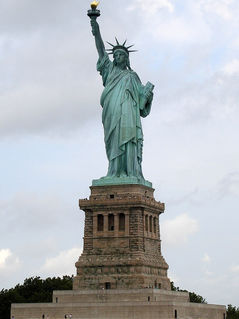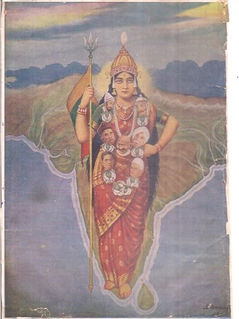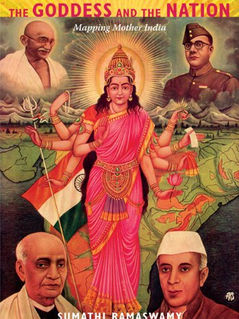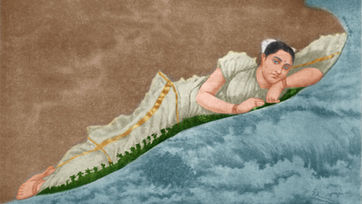
Patriotic Goddess
The tradition of personifying nations and kingdoms is very old and tends to be representations of political, and cultural ideas of the nation. Since deities and symbolic images were frequently used to represent concepts in ancient times, these figures often have historical roots. The vision of nations as women, often a warrior or motherly figures, symbolizes the idea of the land that protects, nourishes, and uphold the life of the people. The disambiguation, motherland, is another aspect of this tradition. Some notable examples of patriotic female figures around the world are; Mother Albania of Albania, Mother Armenia of Armenia, Finnish Maiden of Finland, Marianne of France, Germania of Germany, The Lady of Hungaria of Hungary, Italia turrita of Italy, Mother Russia of Russia, Bharat Mata of India, Zealandia of New Zealand and Britannia of United Kingdom. Some examples of historical deities representing nations are Roma, the personification of ancient Rome; Libertas, the Roman goddess of liberty, as the "Statue of Liberty" symbolizes the United States of America; and Ériu, an Irish goddess, represents Ireland.
In India, the practice of personifying a region or nation as a goddess appeared in the 19th century. It resulted from the rise of Nationalism during the Indian Rebellion of 1857 against the British. The concept of this movement was to infuse nationalistic pride among the citizens. Although the traditions of goddesses associated with kingdoms are very ancient to the Indian subcontinent. Some notable examples are Sharika Devi of the Baj Basanta dynasty, Urga Tara of the Kalinga dynasty, Banashankari of The Badami Chalukya kings, and Bhavani of the Maratha Empire. Traditionally there are also several regional goddesses as guardian deities throughout India, enfolding both urban and rural regions. (Read: Regional Goddesses)
Bharat Mata
Bharat Mata is the Patriotic goddess and personification of India as a mother goddess. Her image formed with the Indian independence movement of the late 19th century. In the 1920s, she became a political icon but by the 1930s, she entered religious practice as an aspect of Shakti. The motto ‘Bharat Mata ki Jai’, which means “Victory for Mother India”, is often used by the Indians. She is usually depicted with two or four hands and in a saffron sari holding the National flag of India or a saffron Hindu flag and sometimes various other attributes. She is sometimes shown with a lion, an aspect of Shakti. During Durga puja, idols of the goddess Durga is shown as Bharat Mata in some part of Eastern India linking the patriotic image with the cultural identity.
Apart from Bharat Mata as the national goddess of India, South Indian states also have their respective patriotic goddess. This could be a result of strong cultural loyalty in these states. The development of patriotic goddess started in the 19th century with the rise of cultural nationalism and the crafting of concepts out of traditional myths and legends in South India, thus bringing up newer goddesses like Tamil Thai, Telangana Thalli, Telugu Thalli, and Kannada Thai. These goddesses reflect the culture and prosperity of the region.
Telangana Thalli
She is the patriotic mother goddess for the people of Telangana. The original Telangana Thalli statue was designed by B. Venkataramana Chari, a Nirmal resident, and was installed at the TRS office in Jubilee Hills in 2003. The Goddess is depicted holding maize corn in one hand and Bathukamma, a flower stack used in a festival celebrated in Telangana, in another hand.
Telugu Thalli
She is the patriotic mother goddess for the Telugu people and the personification of their culture. She depicted holding the harvest in her left hand and a Kalash in her left hand. The goddess is dressed in the traditional Telugu style. Her image originated from “Maa Telugu Thalliki”, the official song of the state of Andhra Pradesh. It was written by Sankarambadi Sundaraachari for the Telugu film Deena Bandhu (1942).
Tamil Thai
She is also called Thamizhth Thaai, who is the personification of the Tamil language as a mother goddess. Her image originated during the Tamil Renaissance movement of the latter half of the 19th century. The goddess is depicted holding scripture in the left hand and right hand in Abhaya mudra. Tamil Thai Kovil is a temple located in Karaikudi in the Sivaganga district, in which the presiding deity is Tamil Thai. This is the only temple in the world for worshipping a language as a deity.
Kannada Taayi
She is the patriotic mother goddess for Karnataka and is considered an aspect of Bhuvaneshvari. She is depicted with four arms, holding the flag of Karnataka, a crop, and a kalasha with flowers and scripture.
Personification of Kerala
Kerala never had a patriotic goddess of the state or personified image of culture because of the lack of a centralized political system or cultural nationalism. In the 1930s, the ideas of Mother Kerala were tried to infuse. Sreemathi, a popular magazine, in its annual special publication of 1935 highlighted the image of a lady, named Kerala Matavu, lying across the geographic spread of Malayalam-speaking land. She was portrayed as a normal human lady in traditional white sarees of Kerala.
Bangamata
The Bengali Renaissance gave birth to the personification of Bengal known as Bangamata, which became a representation of Tripura and West Bengal in India as well as Bangladesh in various Bengali poetry, literature, and patriotic songs.
She is a mother goddess symbolizing Indonesia. Her origin comes from pre-Hindu ethnic communities who revered the earth and natural spirits. Her figure came to be known as Prithvi, the Hindu mother goddess of the earth, once Hinduism took root in the first millennium, and she was given the name "Pertiwi."
Sri Lanka Matha
The national song, "Sri Lanka Matha," which translates to "Mother Sri Lanka," was written by Ananda Samarakoon and received full constitutional recognition in the Second Republican Constitution of 1978. The anthem is dedicated to Sri Lanka as the motherland.














